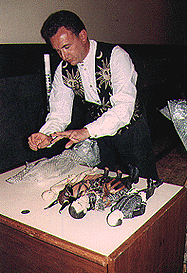William Moritz with the Anima Mundi Festival Director, Marcos Magalhs. Courtesy of William Moritz.
The fourth international Anima Mundi animation festival took place in Rio de Janeiro August 16-25, 1996, overlapping a bit with Hiroshima. Unlike the rather hectic pace and nervous business rivalry of the older and bigger festivals, Anima Mundi offers a relaxed and user-friendly atmosphere for discovering and enjoying animation.
Naturally, it is rather hard to separate the event from the city of Rio, which is one of the most dazzling places, with its perfect weather,...
 William Moritz with the Anima Mundi Festival Director, Marcos Magalhães. Courtesy of William Moritz.
William Moritz with the Anima Mundi Festival Director, Marcos Magalhães. Courtesy of William Moritz. 
The fourth international Anima Mundi animation festival took place in Rio de Janeiro August 16-25, 1996, overlapping a bit with Hiroshima. Unlike the rather hectic pace and nervous business rivalry of the older and bigger festivals, Anima Mundi offers a relaxed and user-friendly atmosphere for discovering and enjoying animation.
Naturally, it is rather hard to separate the event from the city of Rio, which is one of the most dazzling places, with its perfect weather, beautiful beaches, exotic Amazonian fruits and vegetables, romantic 18th and 19th century buildings sandwiched between modern skyscrapers and expansive parks. And the fabulous Carmen Miranda Museum, with her astonishing shoes, jewelry and hats on display together with movie stills and snapshots showing them in their original setting. Carmen's sister Aurora (whose animation credentials include singing and dancing with Donald Duck in Disney's Three Caballeros) regaled us with anecdotes about Walt and Mary Blair staying at the Hotel Gloria (where the festival guests also stayed), and she attended screenings, where she showed good taste by pronouncing Barry Purves' Achilles exquisite.
Guests, Screenings, etc.
The guests at previous Anima Mundi festivals included Frédéric Back, Joan Gratz and Jan Svankmajer. This year, in addition to Barry Purves, with his very hand-made puppet films, a seminar on computer graphics brought Bill and Susan Kroyer, Henry Anderson, Jane Flint DeKoven and Carlos Saldanha (who offered workshops), and portfolio screenings by companies such as Digital Domain, PDI, Pixar and Rhythm & Hues.

Screenings are held in four state-of-the-art theaters housed in the Bank of Brazil and Post Office headquarters, large buildings across the street from each other, which also permanently house an arts bookstore, art galleries, a cafe, tea room and a restaurant. The huge lobby of the Bank of Brazil was set up as an animation school, tended by real animation students, where you could try out drawing-on-film or paper, clay modeling, or computer animation and see the results played back on monitors (or in the case of the drawn-on-film, on an "antique" moviola).
One of the galleries displayed the excellent exhibition Animagia, 100 Years of Animation, borrowed from Annecy. It began with an uncanny life-sized automaton of Émile Reynaud projecting his Théâtre Optique of Poor Pierrot in 1892 and included models of most animation techniques (pin-screen, scratch-on-film, paint-on-glass, etc.) up to computer graphics. As a parallel, I presented two two-hour programs of films tracing masterpieces of animation over the last 90 years.

Competition Screenings
The competition screenings included some 60 films from 20 countries, with an enormous variety ranging from Dave Borthwick's harrowing hour-long The Secret Adventures of Tom Thumb to the hilarious two-minute Dutch cartoon Safe Sex--The Manual, from Igor Kovalyov's dark surrealist vision Bird in the Window to lyrical abstractions such as Clive Walley's Divertimento No. 3, Aleksandra Korejwo's Carmen Habanera and Amy Alexander's beautiful computer-graphic Unbroken Pieces. Prizes, including a $1,000 first place, were awarded entirely on the basis of audience vote--a ballot came with each admission ticket. All of the competition programs were screened seven times, at least once in the afternoon, once in the evening, once on a weekday, once on a weekend. This meant that one could see everything leisurely, a few things each day, and still enjoy all the other delights of the festival and Rio. The grand prize, not unexpectedly, went to A Close Shave, but second place was awarded by the audience to Michaela Pavlatova's Repete, a much more experimental work. Third place went to John Dilworth's 7-minute cartoon The Dirdy Birdy, which successfully recaptures and updates the Tex Avery/Warner Bros. formula. The best children's film award went to a magnificent half-hour Iranian film, Kuh-e Javaher (The Jeweled Mountain), which rivaled the golden-age Czech puppet films in its elaborate detail and truly cinematic storytelling. The Busby Berkeley "Blue Sky" musical cockroach number from Joe's Apartment also received many votes, even though it appeared on an informational computer-graphics program rather than in competition.

 The Jeweled Mountain by Abdollah Alimorad. Courtesy of Anima Mundi. Limbo by Bériou. Courtesy of Anima Mundi.
The Jeweled Mountain by Abdollah Alimorad. Courtesy of Anima Mundi. Limbo by Bériou. Courtesy of Anima Mundi.
The most touching event of the festival was a screening of a fine Brazilian film, The Eight-Pointed Star by the elderly Fernando Diniz, who spent many years in a mental institution, and whose drawings and clay animations were documented on film by the Friends of the Museum of Images of the Unconscious. Diniz's artwork is truly imaginative and interesting in its own right, and the time-lapse footage of him painting is fascinating. The film had just won an award at another festival, and he received the trophy at Rio in the presence of his long-time doctor, now an ancient woman in a wheel-chair, and a wildly enthusiastic audience.
William Moritz teaches film and animation history at the California Institute of the Arts.







